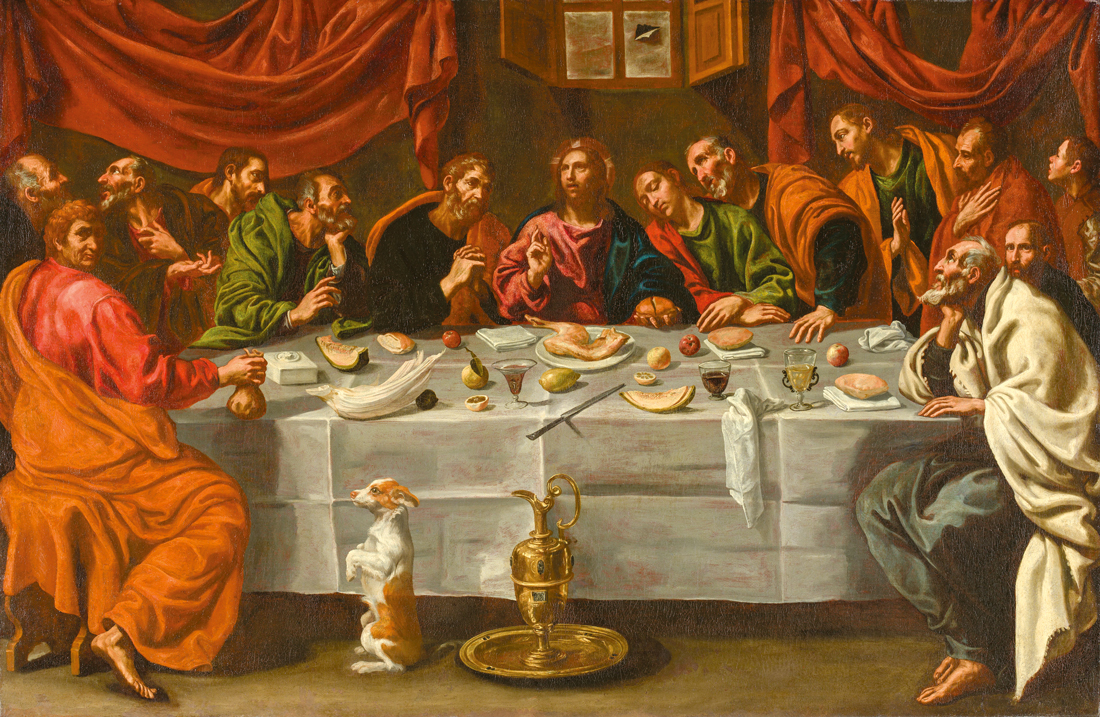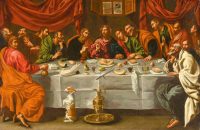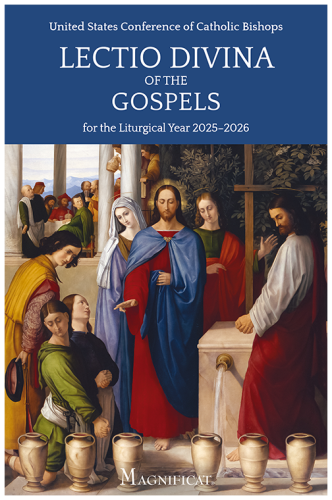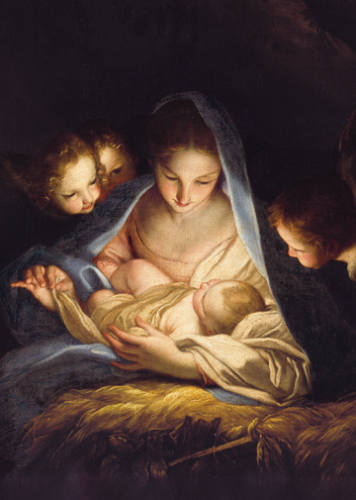The Last Supper (c.1620), Luis Tristán (c. 1586–1624).
Prado Museum, Madrid, Spain.
The table is a riot of opulence. Pieces of sweet melon edge their way among bitter lemons that lie whole or wheel sliced through the cloth’s white expanse. Apples erupt in fiery contrast to sandy rounds of bread placed delicately on folded linens or left neglected to the side. A leg of lamb lies bare on a plate. A marble salt-cellar encloses tomb-like its costly burden. Wine glows red and white in vessels of translucent glass. A knife, long and thin, protrudes with quiet menace. This is the Last Supper.
Stilling the heart
The Spanish painter Luis Tristán offers the viewer an unusual lens into the events of Holy Thursday. At first glance, the painting seems squarely divided into two unrelated parts: the welter of finery on the table and the more familiar ring of apostles around the table, with Christ in the center. Yet this is one scene and not two; what happens on the table is as much a part of the painting as what happens around it.
Tristán brings the viewer into the mystery of the Last Supper by deploying the art of the still life, which, under the patronage of the pious king Philip III, was just beginning its ascendancy in the visual language of 17th-century Spanish art. Put simply, a still life is a painting of ordinary objects—often fruits, flowers, meats, or tableware—arranged to contrast their different textures, colors, and shapes. For the viewer, the still life can be a challenge, since there is no story to catch the mind, no obvious meaning to be harvested.
That’s part of the point: the genre is meant to slow the mind, to train the eye to look more deeply at what it sees. For the painter and the viewer both, the still life invites a kind of beholding where objects of great splendor are subjected to intense contemplation to reveal their humble materiality, and where the humblest matter is contemplated until its radiant splendor reveals itself. In Tristán’s hands, this astonishing back-and-forth of contemplative insight has one source and one infinite horizon: the Eucharist.
A world made liturgy
The varied pageantry of the objects on the table is brought to a climax in the small, broken loaf of bread in Christ’s left hand. To the eye, the loaf is no more or less splendid, no more or less ordinary than anything else on the table. Yet Christ’s right hand held in blessing combines with the other details of the scene to reveal that we are witnessing the central drama of the Last Supper: While they were eating, Jesus took bread, said the blessing, broke it, and giving it to his disciples said, “Take and eat; this is my body” (Mt 26:26). The bread deserves our minutest contemplation because it is other than what it appears: This is the body of the One who holds it.
But Christ’s face suggests that the painting is more than an illustration of the event that took place the day before the crucifixion. Tristán depicts Christ in the physical posture described in the first Eucharistic Prayer of the Mass, showing how he “took bread in his holy and venerable hands, and with eyes raised to heaven,” blessed, broke, and gave the bread to his disciples. Jesus is not merely celebrating a ritual meal with his disciples; he is instituting a liturgy, a pattern of prayer that elevates human words and deeds beyond their normal powers, to make Christ’s true Body and Blood present in the sacrament of the Eucharist.
The liturgical patterning of Tristán’s work opens up new horizons for the still life tableau covering the table. The leg of lamb on the table becomes a new mode of seeing Christ’s action at the Last Supper-Mass, with the element of sacrifice dramatically in view. The ominous knife suggests the blade used to slaughter the Passover lamb, which is present as sacrificial meal on the table and as eternal liturgy in the person of the Lamb of God, offering his body and blood at the table-made-altar. Seen in this light, the ordinary objects that round out the still life reveal the power of the Eucharistic liturgy spilling out into all aspects of human experience, and unveil the deepest beauty of which all earthly contemplation is a distant image: adoration of the Lamb who was slain in heaven’s eternal liturgy.
Two ways of beholding
In gazing upon Tristán’s Last Supper with the eyes of the body, the eyes of the heart receive an invitation to limitless communion with the Lord who has made himself present to humanity in the humility of the Eucharistic matter. Yet the image itself poses a question to the viewer’s heart: What do you want to see? Two sets of eyes gaze out at the viewer from within the image’s action. On the painting’s left, we see Judas, whose shadowed eyes look away from the table, blurrily struggling to spy out a future where his purse of silver would be worth its price. On the right, we see Tristán himself robed as one of the twelve apostles, gazing out at the viewer with clear, bold, questioning eyes, to ask if we want to see as he has learned to see.
The Eucharist present in Tristán’s painting does not impose itself on the viewer, any more than Tristán’s Eucharistic view of reality does. Jesus’ action at the Last Supper, as at the Mass, does not compel the heart to believe. It is possible to look at the Bread of Heaven and see a mere loaf, and to see cut fruits, meat, and wine as nothing more than food for the stomach. But this is not the only way to see. This table is an altar and this bread is God. The world is ablaze with heaven’s own opulence. Let those who have eyes to see, see.
Father Gabriel Torretta, O.P.
Scholar of medieval Christianity who teaches theology at Providence College in Rhode Island.













Additional art commentaries